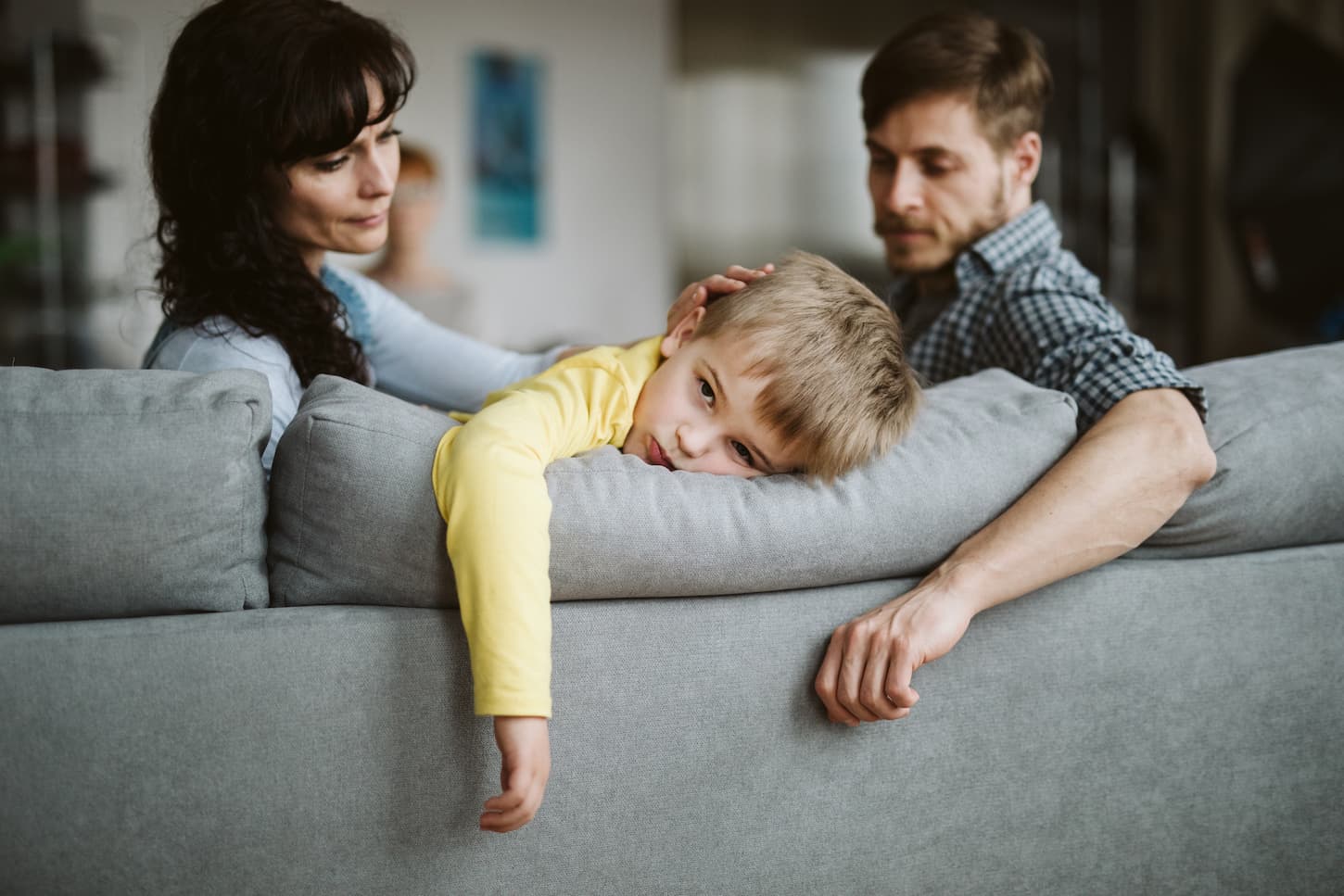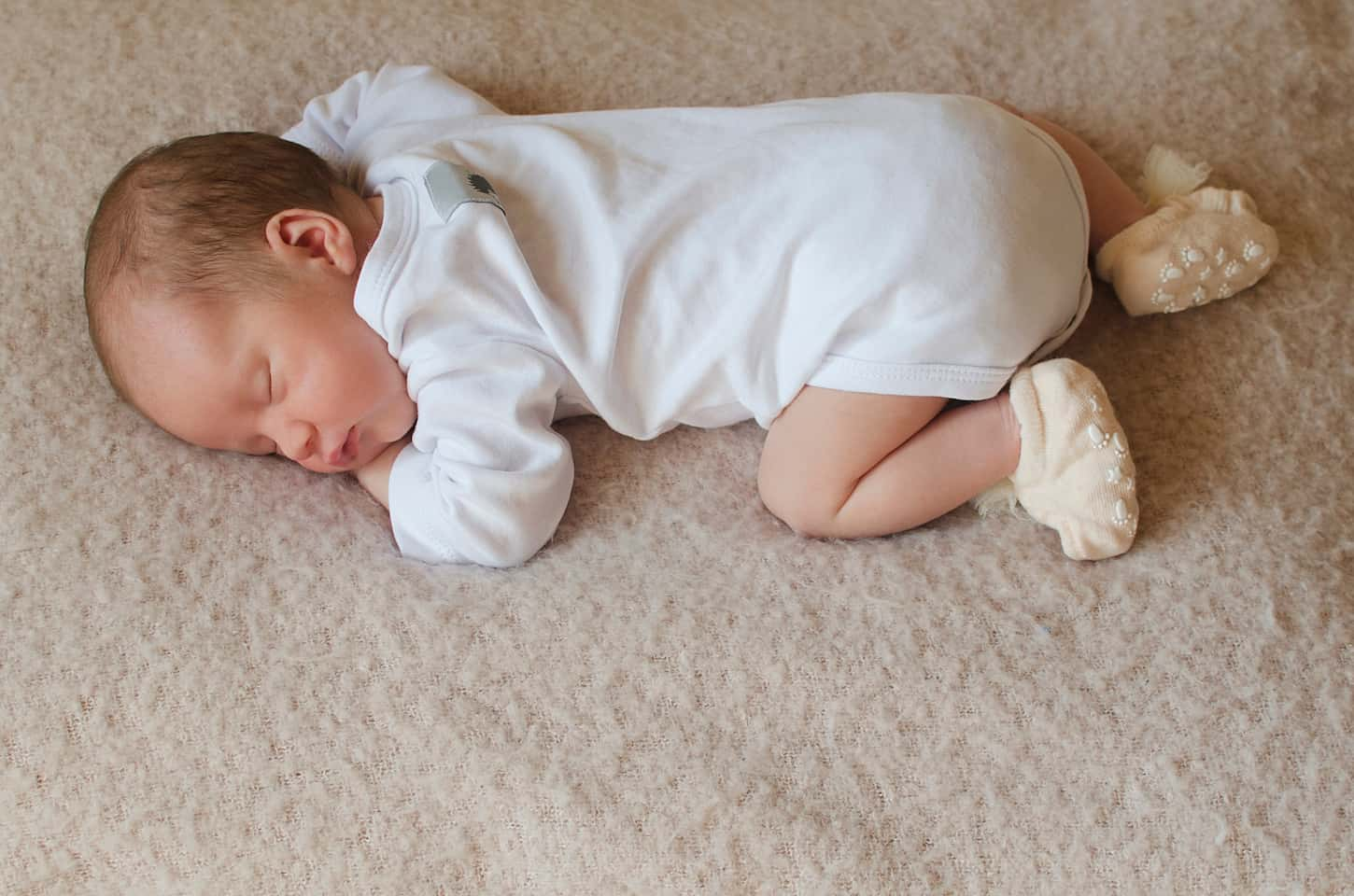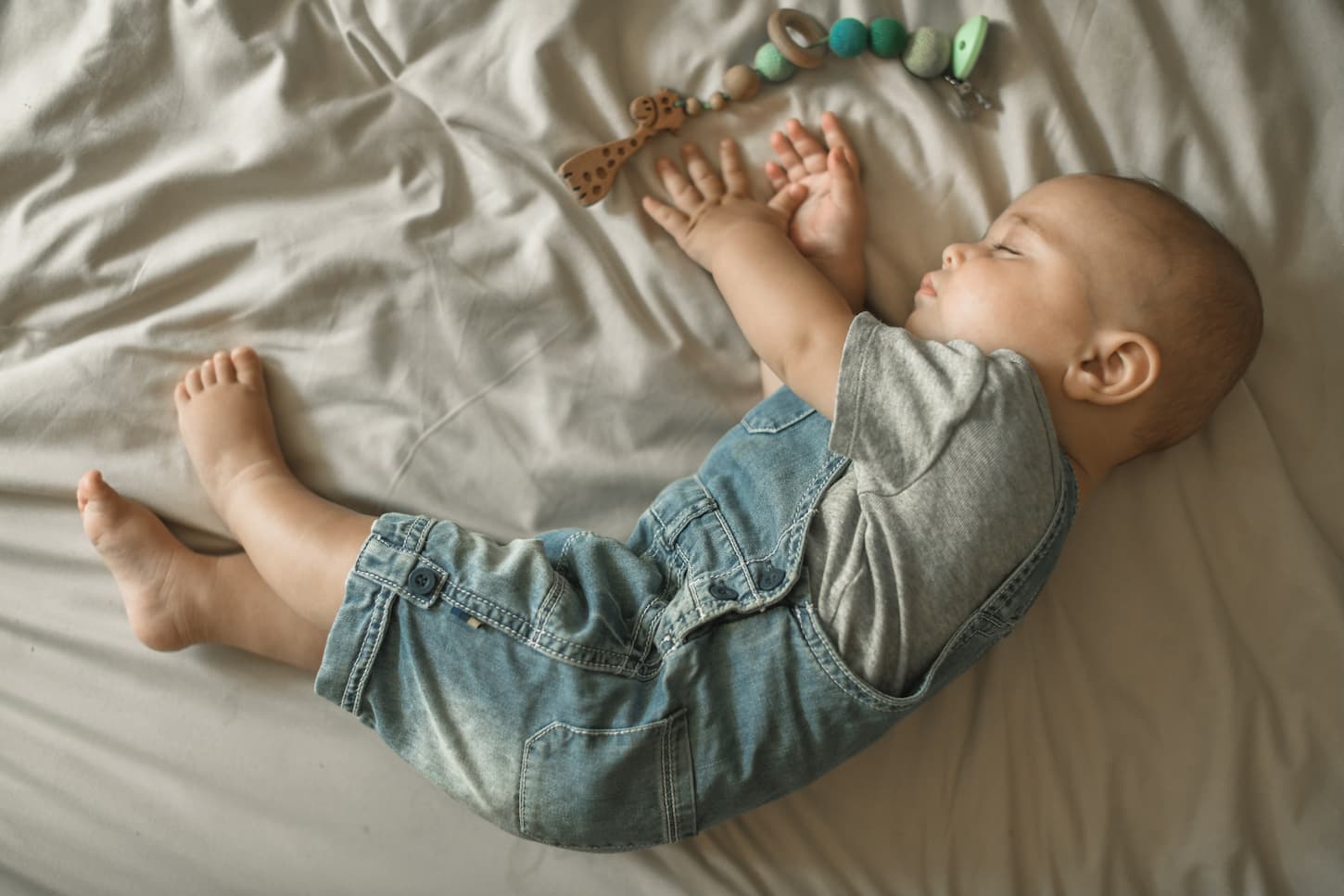Have you ever wondered if there were a better way to sleep train? Perhaps a routine that could make things easier? After extensive research and trying things with our kids, here’s what I’ve found.
Having a sleep training routine makes sleep training easier, faster, and more likely to succeed. Sleep training routines can be as simple as having a regular daytime routine, age-appropriate naps and nap routines, a bedtime ritual, and a plan for handling nighttime wake-ups.
Ready to learn why you need a sleep training routine – and how to create one? Keep reading for all of the best tips.

Sleep Training Routine: Why You Need One
Most people do best with a regular, reliable, and repeatable routine. Not because it constrains us, but because it gives us a sense of familiarity. Kids are the same. They love knowing what’s going to happen and being familiar with the routine.
A routine, it’s not a hard-and-fast never-changing thing. To borrow a concept from a popular movie, think of routines this way: it’s a guidelines more than a rule. Having a regular routine means knowing that you need to have dedicated time to these important scheduling factors.
The exact time of those factors may have some wiggle room each day. Or you may just do things in a specific order (and not worry about the exact timing).
In my experience, having a specific order for the day (and not worrying about the time that’s on the clock) works best for newborns and small children.
That being said, please remember that there’s not a “right” routine or a “wrong” one. There’s just what works for your family and then everything else. So finding what works for your family will be the key. And it will take some time, experimentation, and a whole lot of patience. That’s normal.
As you start setting your family’s routine, here’s what needs to be included.
- A dedicated wake-up time.
- Scheduled (ish) feeding times that are appropriate for your child’s needs and wants as well as their developmental age.
- Nap times that are reasonable and appropriate for your child’s sleep needs.
- Playtime for learning, growing, and getting worn out in preparation for sleep. Have some fun – and have some outdoor time each day.
- A dedicated bedtime that makes sense for your family and allows your child to get the sleep their body needs.
Some children will need more rigid routines. Other children will love having a few surprises. It’s going to depend on their personalities, family dynamics, and personal preferences.
My children (and our family) prefer a more set routine. We allow for some flexibility at nap or rest times, but meals are family events at set times during the day.
How to Craft an Initial Sleep Training Routine
Start with a baseline routine. The exact routine you pick should depend largely upon the ages and needs of your child (or children).
Need some suggested routines? Here are some of the most popular, based on talking to hundreds and thousands of parents in various parenting forums and after reading tons of sleep training books. We’ll go into more detail on the specific methods later on in this article.
| Age of Child | Routine Suggestions | Rationale |
|---|---|---|
| Newborn to 4 Months | Eat, Play Sleep (also known as Eat, Wake, Sleep) | This model works great with newborn sleep patterns and is easy to remember. At about 4 months old, this may evolve into the baby wake window method. |
| Newborn to 18 Months | Sleep/Wake Windows | This model uses prescribed (by age) windows of wakefulness as a guide to your daily routine. This can get more complicated but is still a very popular method. |
| Toddler+ | A/B Days or Set Schedules | Some toddlers do well with having a set schedule, including set nap times. Sometimes these set schedules involve A/B style days, especially during a nap transition. |
Once you’ve picked an age-appropriate method, it’s time to fill out a detailed plan. After sleep training our four children, here are some vital details to include in your plan.
| Details to Include in Your Sleep Training Plan or Routine | Examples (based on our experiences) |
|---|---|
| What will you do when your child is ill during the day? | For minor illnesses (colds, coughs), we added extra “rest time” and cuddles during the day. Some of these turned into extra naps. |
| How will you address nighttime wake-ups with an ill child? | We planned on going in and comforting our child while ill. We gave an age and situation-appropriate medicines if needed. |
| Will you pause the sleep training routine for illness? | We stepped back from nighttime sleep training during illness. Once our child is improving, we used fading to get back on track. |
| How will you manage missed or low-quality naps? | We instituted an earlier bedtime to keep the day (as a whole) on track. |
| How will you manage too-early wake-up times? | For us, we treated too-early wake-ups as nighttime waking. |
| What will you do if your child falls asleep in the wrong place or at the wrong time? | If our child falls asleep, we let them sleep. Odds are this means “in the car” – and we’ll try to transfer them to their bedroom/bed. |
Having a plan is key. But so is having a backup plan for what to do when things don’t go according to plan. It will take time, practice, and experience to develop plans and backup plans for your family. Next, let’s talk about how to adjust your plan.
How to Adjust the Routine as Needed
Now that your plan has been made, it’s time to implement it – and see how it actually works. That way, you can make changes as needed.
The actual changes you’ll make will depend on your family, your situation, and what works for your children.
- If something’s working, don’t change it. Brainstorm some backup plans just in case – but stick with it.
- If what’s working goes against the grain (or what the experts say), that’s okay. They aren’t the experts on your family – you are. Keep using what works and evaluate it.
- If something doesn’t work, change it. Try a few new options to see what works.
Here are some of the most important changes we learned – usually the hard way.
| Changes to Our Sleep Training Plan or Routine | Rationale |
|---|---|
| Our sick kids get to nap wherever (and whenever) they want. | When ill, our kids didn’t want to sleep anywhere but with me. So during the day, we snuggled on a recliner for nap time. This helped them sleep better and recover faster. |
| Sick kids who wake up at night get comforted. | When our kids are sick, we take turns going in to comfort them as needed. It’s exhausting in the short term, but it helps speed up recovery time for our kids. |
| Teething kids get a pass on naps, too. | Teething makes our kids cranky – so we cut them some slack while teething. |
| Early bedtime routines are our favorite thing. | If we wait to start bedtime routines until kids are cranky, it’s too late. We prefer to start bedtime rituals a few minutes earlier – so kids go to bed happy and there’s time for cuddles. |
| We use wake-up clocks to minimize early wake-ups. | Getting a wake-up clock has been a lifesaver on many occasions. To see which bedroom gear and wake-up clocks I recommend, click here. |
| Sleeping kids get to sleep. | If our kids fall asleep, they get to sleep. If it’s at home, we leave them where they are (but make them comfortable). If it’s in the car, we’ll transfer them to their bedroom – if we can. |
Another thing that has been a lifesaver for our family was using an A/B style routine to manage sleep training. Keep reading – we’ll talk about it both through this article and in detail at the end of it.

Sleep Training Routines During Sleep Regressions and Disruptions
There are a couple of ages where, despite your best sleep training efforts, your child may hit a sleep regression or disruption that throws all of your hard work into chaos. It’s not ideal, but it is normal enough that there are some ages where you can almost expect some issues – if not a full-out sleep regression.
The major sleep regressions can be expected at 4 months of age, between 8-10 months old, and at 18 months of age. To read more about when sleep regressions happen, be sure to read my article about it here.
Not every child will experience every sleep regression, though. Even so, let’s help you be prepared for them by planning for them in your sleep training routine. That way, whether they happen or not, you’ll be ready for things.
| Common Sleep Regression Causes | Adjusting Sleep Training Routines | Rationale or Examples |
|---|---|---|
| Sickness or Illnesses | You can continue to sleep train through sickness or you can take a step back, depending on your methodology. | This is a big enough topic that we’ll cover this in more depth later in the article. |
| Teething | Your baby may need more physical reassurance while teething, so use more cuddling (daytime, nighttime, or both) to comfort your child. You may also want to use age and weight-appropriate medicines to help manage pain symptoms. | Be sure to consult your pediatrician about any medicine dosages or use. |
| Developmental Milestone Related Sleep Regression | Continue with sleep training – just know that there will be a rough few days. Use an earlier bedtime to your advantage. | Consider using A/B days for naps and bedtimes as needed. |
| Anxiety, Worry, or Big Changes | This is more of an issue as children get older or if there’s a big change. Talk to your child about things and give them time to adjust. Consider “falling back” to a gentler method. | Moving or moving into a new bedroom (or bed) can be hugely disruptive to sleep. Keep sleep training, but evaluate your methodology. |
| Nightmares, Night Terrors | These are most usually related to being overtired or exhausted. Getting better (and more) sleep for a few nights should resolve the issue. | Use an earlier bedtime for several nights and consider an A/B style schedule for a few days. |
| Travel or Vacation | This may be a combination of “big changes” and time changes. As such, plan for a few days of rough sleep. Know that there will probably be an adjustment period during travel and another upon returning home. | Consider changing to the time zone of where you’ll be as soon as possible to minimize the effects of jet lag. |
| Time Changes (Daylight Savings) | If possible, start adjusting your daily schedule a week before the time change – in small, 10-minute increments to minimize disruptions. | Or expect a few difficult days after the time change. Use early bedtimes to get back on schedule. |
By already having a plan in place for your sleep training routine, you’ll be able to better manage any disruptions or regressions – and minimize their impact on everyone’s sleep.
Sickness and Sleep Training Routines
When your baby gets sick, sleep training routines are probably going to hit a little bit of a wall. And that’s both normal and to be expected. After all, the sickness needs to be resolved before sleep training can see more progress.
But that doesn’t mean you have to completely stop your sleep training all the way.
Instead, just adjust your sleep training routine to accommodate the illness. Here’s what I’ve found, based on research, experience, and talking to other parents who are sleep training.
| No-Tears Sleep Training Methods | Cry-it-Out Sleep Training Methods |
|---|---|
| You can continue to sleep train through sickness. | Take a step back from sleep training during sickness. |
| Your baby may need more physical reassurance during sickness, so use more cuddling to comfort your child. | You can fall back to a no-crying, comforting-focused sleep training method like fading. Doing so should prevent losing all of your existing progress. |
| Don’t count the time when your baby is sick in the total time it takes to sleep train. | Resume your preferred cry-it-out method once the sickness has resolved. |
Taking a small step back (while your child is ill) won’t derail sleep training. Instead, it will help focus everyone’s efforts on getting enough rest to recover from the illness faster. Then, once everyone’s feeling better, you can resume dedicated sleep training.
When our kids get sick, we fall back on a gentle fading method. That way, we can go comfort our kids as needed, manage their symptoms in an appropriate manner, and still keep them on track to a good night’s sleep. That way, they feel comfort, love, and support – and they get better without sacrificing anyone’s sleep.
Just know that this isn’t a fast process.
And please be sure to talk to your doctor if you’re ever concerned or their symptoms get worse. Your pediatrician can help you manage symptoms or give you age and weight-appropriate dosages for common medicines that will help with whatever illness your child is facing.


Sleep Training Routines by Age
Now let’s get into more detail about how to set and manage sleep training routines by age. Please remember that these schedules aren’t hard-and-fast rules – but are great guidelines for helping you settle into a daily routine that will maximize your sleep training efforts.
Please feel free to adjust things as needed to meet your family’s needs. Do that by keeping track (and writing down) of how the basic guidelines work – and what needs changing to reach your ideal sleep situation goals.
Routines for Newborns and Babies
The standard schedule for babies is this:
Eat, Play/Wake, Sleep.
Some routines call for set wake times that will help guide how long one cycles through each of these three activities. There’s an awful lot of data, so you may need to scroll – or even turn your device long-wise so it’s easier to see everything all at once.
| Age | Number of Naps | Average Nap Length | Wake Time Between Naps | Bedtime | Nighttime Sleep Requirements | Sleep Needed in 24 Hours |
|---|---|---|---|---|---|---|
| Birth to 6 weeks | 4 to 8 | 15 minutes to 4 hours | 45 minutes to an hour | Between 9 and 11 PM | 8 to 14 hours | 14 to 18 hours |
| 6 weeks to 3 months | 3 to 4 | 30 minutes to 2 hours | 1 to 2 hours | Between 8 and 11 PM | 8 to 13 hours | 11 to 15 hours |
| 3-6 months | 3 | 1 to 2 hours | about 2 hours | 8 to 10 PM | 9 to 12 hours | 12 to 16 hours |
| 6-9 months | 3 | 1 to 2 hours | 2 to 3 hours | 8 to 10 PM | 9 to 12 hours | 12 to 14 hours |
| 12-18 months | 1 to 2 | 1 to 2 hours | 3 hours | 7 to 8 PM | 10 to 12 hours | 12 to 14 hours |
| 18 months to 3 years | 1 | 1 to 2 hours | N/A | 7 to 8 PM | 10 to 12 hours | 11 to 14 hours |
| Preschoolers | 0 | N/A | N/A | 7 to 8 PM | 10 to 13 hours | 10 to 13 hours |
| Grade schoolers | 0 | N/A | N/A | 7 to 8 PM | 9 to 12 hours | 9 to 12 hours |
| Teenagers | 0 | N/A | N/A | 8 to 10 hours | 8 to 10 hours |
Sleep Training Routines for Toddlers
For toddlers, most begin outgrowing the set wake times from babyhood (as seen above). Most settle into a more set schedule, with dedicated nap times, meals, and bedtimes. This will vary from family to family, and that’s okay.
Even so, here are a toddler’s usual sleep requirements, just for quick reference.
| Age | Number of Naps | Average Nap Length | Wake Time Between Naps | Bedtime | Nighttime Sleep Requirements | Sleep Required Each 24 Hours |
|---|---|---|---|---|---|---|
| 12-18 months | 1 – 2 | 1 – 2 hours | 3 hours | 7 – 8 PM | 10 – 12 hours | 12 – 14 hours |
| 18 months to 3 years | 1 | 1 – 2 hours | 3+ hours | 7 – 8 PM | 10 – 12 hours | 11 – 14 hours |
| Preschoolers | 0 | N/A | 3+ hours | 7 – 8 PM | 10 – 13 hours | 10 – 13 hours |
What may work well for this age is using an A/B day schedule to manage bedtimes. Keep reading for more information on an A/B schedule.
Big Kids and Sleep Training Routines
Big kids (preschoolers and older) have outgrown the set wake times they may have had as babies. That’s normal. By this age, they’re more than ready to be awake all day (most days, anyway!). They still may need some recess and outside playtime to help them focus at school, though.
Even so, the biggest part of a sleep routine for these kids is going to be having a dedicated bedtime routine and bedtime.
But to keep up the data, let’s make sure you’ve got the average sleep requirements, needs, and data for your big kids.
| Age | Number of Naps | Average Nap Length | Wake Time Between Naps | Bedtime | Nighttime Sleep Requirements | Sleep Required Each 24 Hours |
|---|---|---|---|---|---|---|
| Preschoolers | 0 | N/A | N/A | 7 – 8 PM | 10 – 13 hours | 10 – 13 hours |
| Grade schoolers | 0 | N/A | N/A | 7 – 8 PM | 9 – 12 hours | 9 – 12 hours |
| Teenagers | 0 | N/A | N/A | good luck | 8 – 10 hours | 8 – 10 hours |
For rough days (when there’s some exhaustion coming into play) you may want to still use an A/B day schedule to manage bedtimes. Keep reading for more information on an A/B schedule.
An A/B Day Style Sleep Training Routine and Schedule
Using an A/B day style of sleep routine doesn’t have to be complicated. It can be as simple as having two distinct schedule types – an “A” day for days when everyone’s well-rested and a “B” day for when kids are cranky and/or exhausted.
In that kind of situation, an “A” day would mean a normal bedtime. For this example, let’s say our normal bedtime is 7 PM. Then, a “B” day would be a day with early bedtimes – let’s say 6:30 PM. That way, if there are a few more extra minutes of cuddles at bedtime we’re still getting to bed well before the usual bedtime.
For example, your child has been doing well and is primarily on an “A” day schedule. Then, they catch a nasty cold, so you implement several “B” style days. Once they’re better, you go back to an “A” day bedtime. The next morning, your child is cranky. So you plan for one more “B” day and will reevaluate again the next day.
By having a plan for two different style days (even if it’s just a simple bedtime time change), you’re going to have a plan and a backup plan for continuing to keep your child’s sleep training and sleep quality on track.
And the best part? It can be super simple. In the example above? That’s the exact A/B routine we use for our youngest two kids. Here’s the A/B style day we use for our school-aged kids:
- “A” days mean a bedtime of 7:45 PM (with a “sunset” light that goes out after 30 minutes).
- “B” days mean a bedtime of 7:45 PM with a shorter sunset light of about 15 minutes.
They used to have an 8 PM bedtime, but when we introduced the sunset light we had to push it earlier – because our kids started using the sunset light time as “sibling quiet playtime”. So, we adjusted and keep evaluating. We’ll make changes as needed, but it’s working for now.
If you want to have A/B style days for naps, that’s also an option. When our kids took naps, we had one. Here’s what it looked like:
- “A” days had the minimum appropriate number of naps for the age.
- “B” days had the maximum number of age-appropriate naps.
Then, we just used the eat-wake/play-sleep cycle with wake times to guide what time those naps would be at. Usually, that meant we had a pretty reliable schedule – at least until we hit nap transitions. Then, we used our A/B style days to get through them – and adjusted to the new number of minimum and maximum naps.
Using A and B style days has been a huge part of the reason we’ve seen sleep training success – and it’s helped our kids sleep better.
In any case, hang in there, friend. You’ve got this. And as you keep sleep training, your family will get better sleep. Welcome to Team Sleep – and sleep well.

Related Questions
When Should You Start Sleep Training Your Baby? Dedicated and focused sleep training can begin after about 4-6 months of age, although sleep training “practice” can begin earlier. To read more about why that is and which methods can be used for either focused or practice sleep training, click here.
How Do You Sleep Train without Crying it Out? There are no-cry and minimal-tears sleep training methods, such as fading, pick-up-put-down, and chair methods. These methods work well and are viable, sustainable options. To read more about the fading method, click here.
How Long Do You Let a Baby Cry it Out? Provided your baby is in a safe environment, you may choose to let them cry it out as part of sleep training. On average, it may take 1-2 hours before your baby falls asleep. For more aspects on how long you should let your baby cry, please read this article.